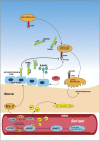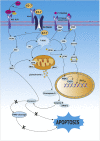Molecular Pathways and Roles for Vitamin K2-7 as a Health-Beneficial Nutraceutical: Challenges and Opportunities
- PMID: 35774605
- PMCID: PMC9237441
- DOI: 10.3389/fphar.2022.896920
Molecular Pathways and Roles for Vitamin K2-7 as a Health-Beneficial Nutraceutical: Challenges and Opportunities
Abstract
Vitamin K2-7, also known as menaquinone-7 (MK-7) is a form of vitamin K that has health-beneficial effects in osteoporosis, cardiovascular disease, inflammation, cancer, Alzheimer's disease, diabetes and peripheral neuropathy. Compared to vitamin K1 (phylloquinone), K2-7 is absorbed more readily and is more bioavailable. Clinical studies have unequivocally demonstrated the utility of vitamin K2-7 supplementation in ameliorating peripheral neuropathy, reducing bone fracture risk and improving cardiovascular health. We examine how undercarboxylated osteocalcin (ucOC) and matrix Gla protein (ucMGP) are converted to carboxylated forms (cOC and cMGP respectively) by K2-7 acting as a cofactor, thus facilitating the deposition of calcium in bones and preventing vascular calcification. K2-7 is beneficial in managing bone loss because it upregulates osteoprotegerin which is a decoy receptor for RANK ligand (RANKL) thus inhibiting bone resorption. We also review the evidence for the health-beneficial outcomes of K2-7 in diabetes, peripheral neuropathy and Alzheimer's disease. In addition, we discuss the K2-7-mediated suppression of growth in cancer cells via cell-cycle arrest, autophagy and apoptosis. The mechanistic basis for the disease-modulating effects of K2-7 is mediated through various signal transduction pathways such as PI3K/AKT, MAP Kinase, JAK/STAT, NF-κB, etc. Interestingly, K2-7 is also responsible for suppression of proinflammatory mediators such as IL-1α, IL-1β and TNF-α. We elucidate various genes modulated by K2-7 as well as the clinical pharmacometrics of vitamin K2-7 including K2-7-mediated pharmacokinetics/pharmacodynamics (PK/PD). Further, we discuss the current status of clinical trials on K2-7 that shed light on dosing strategies for maximum health benefits. Taken together, this is a synthetic review that delineates the health-beneficial effects of K2-7 in a clinical setting, highlights the molecular basis for these effects, elucidates the clinical pharmacokinetics of K2-7, and underscores the need for K2-7 supplementation in the global diet.
Keywords: cancer; clinical trial; diabetes; menaquinone; neuropathy; nutraceutical; osteocalcin; vitamin K2-7.
Copyright © 2022 Jadhav, Ajgaonkar, Saha, Gurav, Pandey, Basudkar, Gada, Panda, Jadhav, Mehta and Nair.
Conflict of interest statement
NJ, SA, PS, PG, AP, VB, YG, SP, and SN are employees of Viridis Biopharma Pvt. Ltd., Mumbai, India. SJ and DM are employees of Synergia Life Sciences Pvt. Ltd., Mumbai, India. This study received funding from Synergia Life Sciences Pvt. Ltd. The funder had the following involvement with the study: SJ prepared Table 4 on other global clinical trials. DM edited the manuscript.
Figures





References
-
- Abúd R. P. (2020). Effect of Vitamin K2 Supplementation on Vascular Calcification in Hemodialysis Patients: a Controlled Randomized Trial. Available at: https://clinicaltrials.gov/ct2/show/NCT04539418 (Accessed October 7, 2021).
-
- ACTRN12619000102178 (2021). Anzctr. Available at: https://anzctr.org.au/Trial/Registration/TrialReview.aspx?id=376779&isRe... (Accessed January 31, 2022).
-
- ACTRN12619000170123 (2020). Anzctr. Available at: https://anzctr.org.au/Trial/Registration/TrialReview.aspx?ACTRN=12619000... (Accessed January 31, 2022).
Publication types
LinkOut - more resources
Full Text Sources

